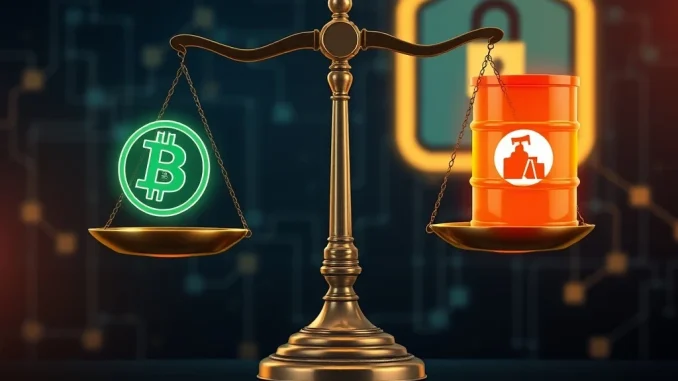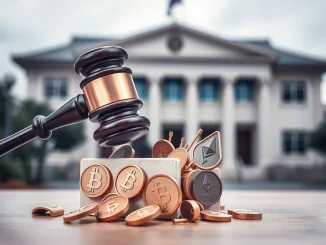
In a significant move highlighting the increasing intersection of traditional crime and digital assets, U.S. prosecutors are making headlines by aggressively pursuing a staggering $7.1 million in cryptocurrency. This substantial sum is tied directly to a massive crypto fraud case rooted in an elaborate oil and gas scheme, underscoring the vigilance of authorities in tracking illicit funds within the digital realm.
The Unraveling of an Elaborate Oil Fraud Scheme
The core of this compelling story revolves around Geoffrey K. Auyeung, who was indicted in 2024 for severe money laundering offenses. Auyeung allegedly orchestrated an extensive oil fraud scheme that siphoned off millions, converting a significant portion into various cryptocurrencies to obscure its origins. This case serves as a stark reminder that as the crypto ecosystem matures, so do the methods employed by criminals, and consequently, the tools used by law enforcement to combat them.
The scheme itself was intricate, leveraging the perceived anonymity of digital transactions to move ill-gotten gains. The fraudulent activities in the oil and gas sector generated substantial illicit profits, which Auyeung then sought to legitimize or conceal through a complex web of financial maneuvers. This transition from traditional financial fraud to digital asset laundering showcases a growing trend that authorities are now well-equipped to address.
Tracing the Digital Footprint: Unpacking Crypto Recovery Efforts
One of the most remarkable aspects of this case is the sophisticated nature of the crypto recovery efforts undertaken by U.S. authorities. Prosecutors revealed that the illicit funds were meticulously funneled through a staggering 81 different accounts. Of these, 19 were identified as cryptocurrency wallets, holding a diverse portfolio of digital assets including Bitcoin (BTC), Tether (USDT), USD Coin (USDC), and Ethereum (ETH).
The ability to trace these funds across numerous accounts and into specific crypto wallets demonstrates a significant leap in forensic capabilities for law enforcement agencies. While the full $7.1 million is being sought, authorities have already successfully seized approximately $2.3 million. This partial recovery highlights both the challenges and successes inherent in tracking assets on decentralized ledgers. The process often involves:
- Analyzing blockchain transaction data.
- Collaborating with cryptocurrency exchanges and service providers.
- Utilizing advanced tracing software to map out fund flows.
The specific mention of BTC, USDT, USDC, and ETH indicates the breadth of cryptocurrencies being used in illicit activities, and consequently, the broad scope of assets that law enforcement must be prepared to identify and seize.
The Legal Battleground: Confronting Money Laundering Charges
At the heart of the prosecution lies the formidable challenge of money laundering charges. Geoffrey K. Auyeung’s indictment for money laundering underscores the severe legal repercussions awaiting those who attempt to clean illicit funds through digital assets. Money laundering, by its very nature, seeks to obscure the origins of illegally obtained money, making it appear legitimate. In this case, cryptocurrencies were used as a vehicle for this obfuscation.
The legal framework being applied in such cases is continuously evolving. Prosecutors are increasingly adept at demonstrating the intent and actions required to prove money laundering, even when digital assets are involved. This includes:
- Proving the funds originated from illegal activities (the oil fraud).
- Demonstrating the steps taken to conceal the source, ownership, or location of the funds (funneling through multiple accounts and crypto wallets).
- Showing the intent to promote the unlawful activity or avoid transaction reporting requirements.
This case sends a clear message: the digital nature of assets does not grant immunity from traditional financial crime laws. The Department of Justice and other agencies are investing heavily in expertise and technology to pursue such cases rigorously.
Are US Prosecutors Crypto Crackdowns Becoming the Norm?
The aggressive stance taken by US prosecutors crypto-related crimes is not an isolated incident but rather indicative of a broader, intensifying trend. Over recent years, U.S. authorities have significantly ramped up their efforts to combat illicit activities involving digital assets. From ransomware payments to dark web marketplaces and now large-scale fraud schemes, the government’s focus on crypto as a tool for crime has sharpened considerably.
This increased scrutiny is driven by several factors:
- The growing adoption and market capitalization of cryptocurrencies, making them more attractive targets for criminals.
- Advancements in blockchain analytics and forensic tools, which empower law enforcement to trace transactions more effectively than ever before.
- A global push for stronger anti-money laundering (AML) and counter-terrorism financing (CTF) regulations in the crypto space.
This case, involving a substantial sum and a complex fraud scheme, serves as a powerful deterrent and a testament to the government’s commitment to upholding financial integrity across all asset classes. It signals a future where digital asset crime will be met with increasingly sophisticated and successful prosecution efforts.
Challenges in Digital Asset Seizure & What You Need to Know
While the U.S. government’s success in seizing part of the $7.1 million is commendable, it’s important to acknowledge the inherent challenges in digital asset seizure and recovery. Unlike traditional bank accounts, cryptocurrencies held in self-custody wallets require access to private keys, which can be difficult to obtain if not voluntarily surrendered or legally compelled. The global nature of crypto also adds layers of complexity, as assets can be moved across borders instantaneously.
For individuals and businesses in the crypto space, this case offers several actionable insights:
- Due Diligence is Key: Always conduct thorough due diligence when engaging in large transactions or partnerships, especially in less regulated sectors.
- Understand Your Exposure: Be aware of how your assets are stored and the security measures in place.
- Regulatory Compliance: Stay informed about evolving AML/KYC regulations, as these are designed to prevent illicit activities and protect legitimate users.
- Report Suspicious Activity: If you encounter anything that seems like an oil fraud scheme or any other suspicious financial activity, report it to the relevant authorities. Your vigilance can help prevent further crime.
Conclusion
The ongoing pursuit by U.S. prosecutors to recover $7.1 million in crypto from an elaborate oil fraud case marks a pivotal moment in the fight against financial crime in the digital age. It underscores the sophisticated capabilities of law enforcement to trace illicit funds, even when disguised through multiple accounts and various cryptocurrencies. This case serves as a powerful reminder that the anonymity often associated with crypto is not absolute, and those who engage in illicit activities, from complex oil fraud schemes to intricate money laundering charges, will face rigorous investigation and prosecution. As US prosecutors crypto enforcement efforts continue to mature, the digital asset landscape will undoubtedly become a safer and more transparent environment for legitimate innovation and investment.
Frequently Asked Questions (FAQs)
Q1: What is the primary focus of the U.S. government’s action in this case?
A1: The primary focus is to recover $7.1 million in cryptocurrency that is tied to an extensive oil and gas fraud scheme and subsequent money laundering activities orchestrated by Geoffrey K. Auyeung.
Q2: Which cryptocurrencies were involved in the money laundering scheme?
A2: The illicit funds were funneled through 19 crypto wallets holding various digital assets, including Bitcoin (BTC), Tether (USDT), USD Coin (USDC), and Ethereum (ETH).
Q3: How much crypto has already been seized by authorities?
A3: Authorities have already successfully seized approximately $2.3 million of the total $7.1 million they are seeking to recover.
Q4: Why is this case significant for the cryptocurrency community?
A4: This case is significant as it demonstrates the increasing capability of law enforcement to trace and seize illicit funds moved through cryptocurrencies, highlighting a growing trend of aggressive prosecution against crypto-related financial crimes like the crypto fraud case at hand.
Q5: What challenges do authorities face in recovering crypto assets?
A5: Challenges include tracing funds across numerous accounts, obtaining access to private keys for self-custody wallets, and navigating the global and decentralized nature of cryptocurrency transactions.



